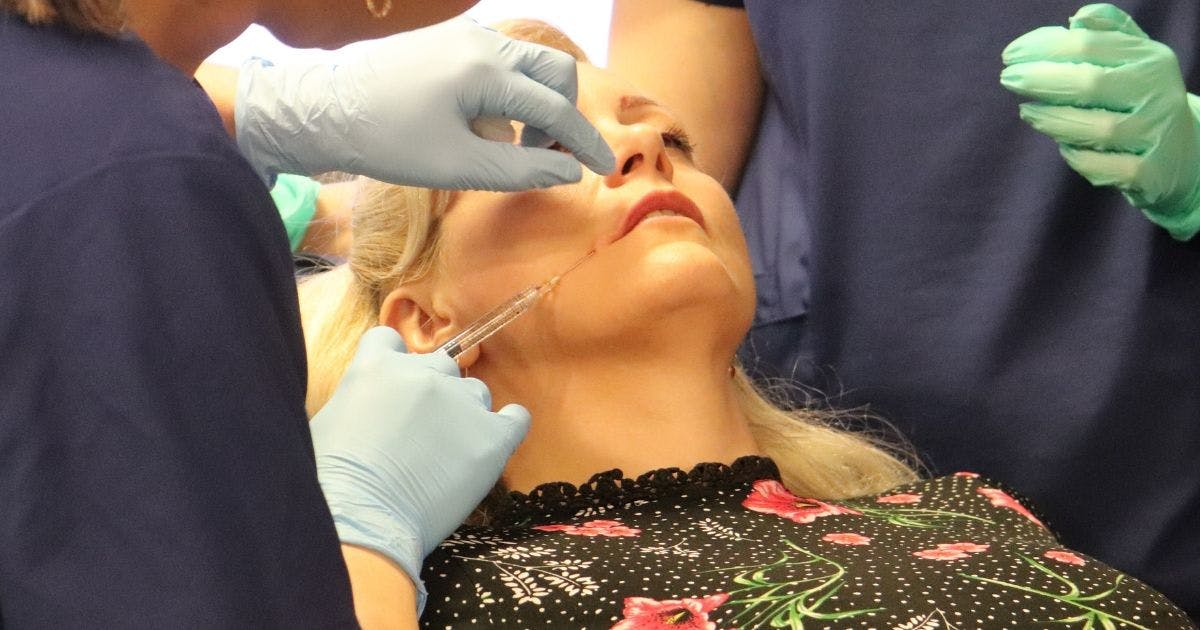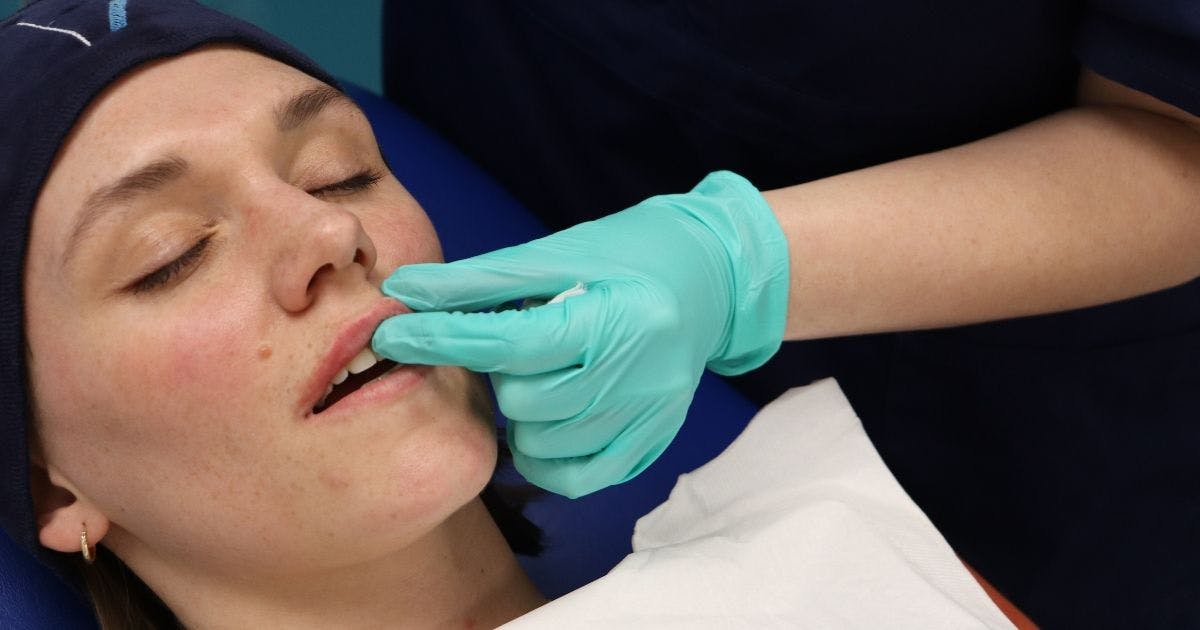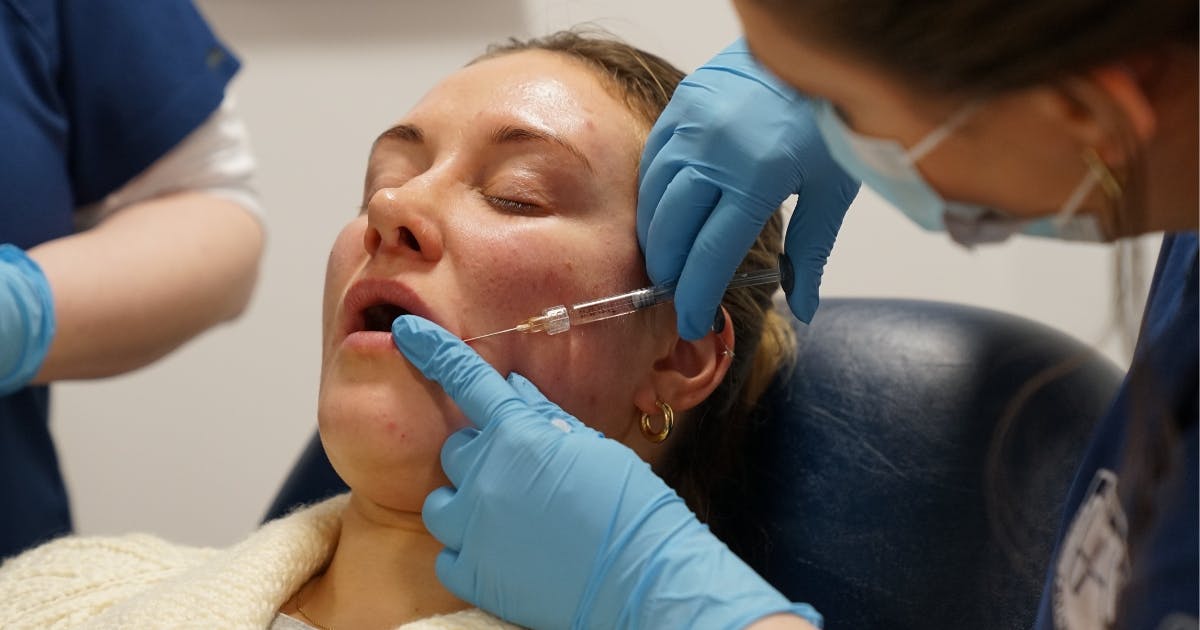Lip Filler Injection Techniques for Restoring Volume

Understanding the range of lip filler injection techniques for restoring volume is great knowledge for all aesthetics practitioners. As we age, we lose volume in our faces and lips, so this will be a concern for many of your patients.
As an injector, you’ll know that lip fillers are one of the most popular aesthetics treatments requested. Knowing how to employ lip rejuvenation techniques that restore volume while maintaining naturalness will guarantee a happy and returning patient.
We spoke to Dr Karla Orsine Murta Dias for her injecting wisdom. Dr Karla successfully completed her Level 7 Diploma in Botox & Dermal Fillers with us at Harley Academy. She now works as a clinical trainer as part of our faculty and is an aesthetics specialist, mentoring the next generation of aesthetic practitioners.
Why does volume loss in the lips occur?
Volume loss is a natural part of ageing, but other elements can contribute too. Dr Karla explains, “Volume loss in the lips can also occur due to various factors such as genetics, sun exposure, and lifestyle habits like smoking.
“As we age, our skin produces less collagen and elastin, leading to decreased firmness and plumpness in the area.”
Selecting patients for lip filler injections
Dr Karla shares, “Identifying patients for perioral and lip rejuvenation treatment involves assessing their aesthetic goals, medical history, and anatomical features.
“Candidates typically have concerns about thin or asymmetrical lips. They desire enhanced lip volume and ideally, are in good overall health.” The ability to assess suitable candidates is a skill that you’ll pick up as you treat more patients and conduct consultations.

Treatment planning for how to restore lip volume
As with any aesthetic treatment, “Treatment planning for perioral and lip rejuvenation includes a comprehensive consultation. Here, you’ll discuss the patient's desired outcomes, assess their lip anatomy, and determine the appropriate filler type, volume, and injection technique.
“Considerations such as lip shape, symmetry, and proportions within the face should also be taken into account to achieve natural-looking results,” Dr Karla notes.
You may even want to look at long-term treatment planning. For example, if a patient has thin lips, you may choose to inject small amounts of filler over a longer period. This can help to build volume and stop any overfilling or undesired results, as you can assess after each treatment before injecting more.
Marking up for lip filler injections to restore volume
Marking up for lip filler injections is a crucial element of the treatment process. This is your visual guide.
Dr Karla highlights, “This involves outlining the desired injection sites and landmarks in the area using a fine-tip marker pencil. Moreover, it helps to guide the injector during the procedure and ensures precise filler placement for optimal results.”
One vital thing to remember here, in terms of infection control, is to remove the markings before injecting. Injecting through your marks can increase the risk of infection so always clinically cleanse the area again before treating.
It’s also important to consider a patient’s ethnicity and facial proportions. This will impact which lip filler techniques you’ll use! She breaks down marking up for male- and female-presenting patients.
Landmarking female patients’ lips
Dr Karla notes, “When marking up, it's important to consider the anatomical differences between male and female lips. This helps to achieve natural and harmonious results.
“For female patients, the aesthetic goals often involve enhancing volume, definition, and symmetry.
“When marking, the focus may be on creating a more pronounced Cupid's bow. You want to add fullness to the upper and lower lips. Concentrate the volume within the nose width, maintaining a balanced and proportionate appearance.”
Men’s lip filler considerations
Dr Karla continues, “Male lip augmentation aims to achieve subtle enhancement while preserving a masculine aesthetic.
“When marking the lips for filler injections in male-presenting patients, it's essential to maintain a more understated and natural-looking look. You may want the volume centralised within the width of the patient’s chin. Also, maintain a straighter vermillion border without overly defining the Cupid's bow.”

Lip augmentation tools and techniques
The next step is figuring out which filler product to use and how you want to inject it.
Dr Karla explains, “Filler product choice and injection technique depends on the patient's needs and preferences. For restoring volume in the lips, hyaluronic acid fillers with a low to medium prime are commonly used.” A lower G prime allows for fluidity and is softer than a higher G prime filler, typically used for areas such as the chin in deeper layers of the face.
Injecting lip filler with a needle
“The selection of needle or cannula and size depends on the injector's preference and the specific treatment area,” Dr Karla tells us.
She shares, “Needles are commonly used for precise and targeted injections. They allow for controlled filler placement along specific areas such as the vermillion border.
“Needles also offer versatility and are suitable for fine detail work, such as defining the Cupid's bow. However, needles may cause more discomfort and bruising due to their sharp tip and potential trauma to blood vessels.”
Restoring lip volume using a cannula
Dr Karla tells us that “cannulas offer several advantages for lip filler injections, including reduced pain, bruising, and vascular complications.
“They have a blunt tip, which decreases the risk of penetrating blood vessels and minimises tissue trauma. However, cannulas may not provide the same level of precision as needles, especially for fine contouring or defining the lip’s border.
“The choice between needle and cannula depends on factors such as:
- The injector's experience
- Patient’s preference
- Treatment goals.
“Some practitioners may prefer to use a combination of both methods to achieve optimal results.
“Ultimately, selecting a suitable filler product and technique requires careful consideration of the patient's anatomy, desired outcomes, and safety considerations.”
To develop your lip filler injection techniques and how to use a needle and cannula, you need the best aesthetics training.
Lip filler injection techniques for restoring volume
We asked Dr Karla what lip filler injection techniques she recommends to practitioners trying to restore volume. She details the following:
Linear threading
“Injecting small amounts of filler underthe vermillion border and in the lip body to enhance definition.” This is a great technique for patients experiencing volume loss due to ageing or thin lips.
Fanning technique
Another approach that’s useful for injecting thin lips is the fanning technique. With this you would “inject filler in a wider distributed fan-shaped pattern to achieve natural-looking fullness and contour,” Dr Karla says.

Additional treatments for enhancing overall facial harmony
As part of your patient’s treatment plan, you may want to consider additional filler and toxin treatments. These can pair well with lip filler injections to address volume loss and can complement their treatment.
Dr Karla states, “Dermal fillers for nasolabial folds or marionette lines can be injected to enhance overall facial harmony.
“Also, in certain patients, you can use botulinum toxin for perioral lines, lip eversion or downturned corners of the mouth to complement lip enhancement results.”
Common mistakes during patient assessment and treatment
Mistakes are a part of the learning experience and as a new aesthetics practitioner, you’re bound to make a few. Dr Karla shares her top tips and mistakes she often sees while mentoring trainees during patient assessment and treatment.
One of the most common mistakes she observes is, “overfilling or underfilling the lips. This can lead to unnatural results.
“Another mistake I’ve seen is discounting the patient’s preferences or failing to communicate effectively about expected outcomes.”
As she mentioned, considering a patient’s ethnicity and facial proportions is also crucial. Neglecting to do so can create undesirable results.
Lastly, “Using improper injection techniques or failing to adhere to sterile procedures.” This can increase the risk of complications and you want to uphold your reputation as a safe aesthetic practitioner.
“By addressing these questions comprehensively and accurately, medical practitioners can ensure safe and effective filler treatments for their patients. This means achieving natural-looking and satisfying results,” she adds.
It’s also important to have the confidence not to treat lips, should you feel the patient is unsuitable. Practitioners should lead with their instincts as specialists, not be led by patient demands which may be inappropriate.
Develop confidence in your lip filler injection techniques
Injecting lip filler is one of the first things you’ll learn as a new aesthetics practitioner getting started in this field. However, this doesn’t mean it’s an easy treatment to master.
Some practitioners would even argue this treatment is for more experienced injectors. There are many baseline lip shapes and a wide range of desired treatment outcomes.
The lips are prone to overfilling and side effects such as bruising. Furthermore, as one of the most searched-for aesthetics treatments, knowing how to treat lips well is a sign of a competent injector.
Most patients will want natural-looking results that seamlessly blend with their proportions, without looking overfilled or too pouty. Patients are often extremely nervous about ending up with this ‘duck lips’ look.
As we’ve expressed above, it’s also important to consider a patient’s ethnicity and how they identify for results that produce aesthetic harmony.
Lip filler training courses for medical professionals
At Harley Academy, we offer several comprehensive dermal filler courses and Injectables Masterclasses. These can take you from a complete novice - with no aesthetic medicine experience whatsoever - to specialist status, depending on the pathway you choose.
Some injectors really enjoy treating lips and decide to become a lip filler specialist. Alternatively, you may really struggle with lips and wish to build your confidence with additional one-to-one mentoring as you treat lip filler patients under their guidance.
For any medical aesthetics practitioner looking to improve their lip filler injecting, we have a dedicated Perioral & Lip Filler Masterclass. Through live injecting demonstrations and a carefully crafted curriculum, you’ll proudly conquer lip filler techniques in no time.
If you’d like to hear more about our specialist-led aesthetic training courses and what Masterclasses we offer - book a call with one of our Course Advisors.
All information correct at the time of publication
Download our full prospectus
Browse all our injectables, dermal fillers and cosmetic dermatology courses in one document
By submitting this form, you agree to receive marketing about our products, events, promotions and exclusive content. Consent is not a condition of purchase, and no purchase is necessary. Message frequency varies. View our Privacy Policy and Terms & Conditions
Attend our FREE open evening
If you're not sure which course is right for you, let us help
Join us online or in-person at our free open evening to learn more
Our Partners












STAY INFORMED
Sign up to receive industry news, careers advice, special offers and information on Harley Academy courses and services


